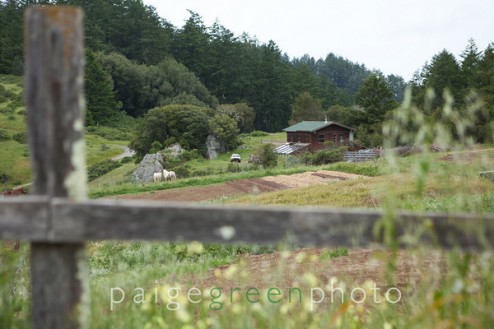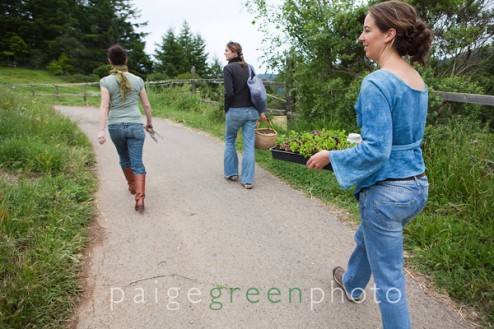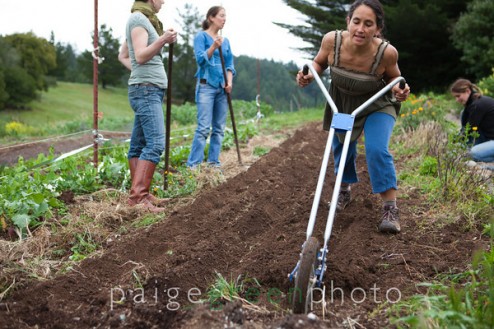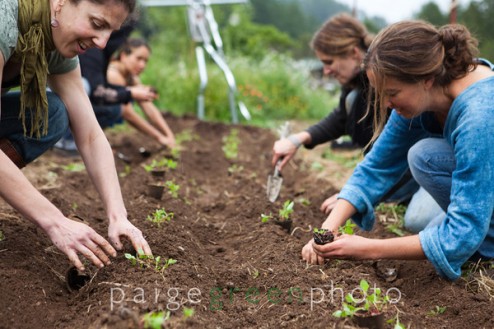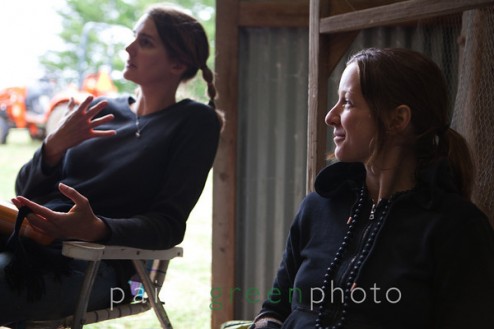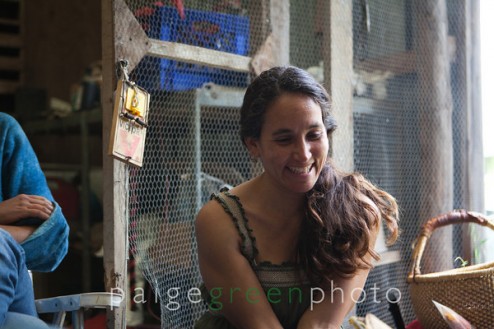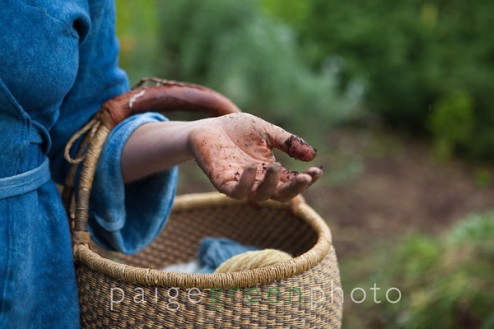The quiet of the sky, and the interspersed drops of rain were a welcoming combination that led us to the western end of the San Geronimo Valley. It is here where Mt. Barnabe stands–its southern exposed slope is covered in chaparral (filled with dye plants), to the north the ridges are dotted with douglas fir, tan oak, and bay, with an understory of wild hazelnuts, and a variety of ferns. Below the mountain’s precipice is the organic Mt. Barnabe Farm. It is here where the Japanese indigo will spend its life.
Polygonum tinctorium, commonly known as Japanese indigo produces a strong spectrum of blues, and will allow us to create a range of colors, when used in combination with native coyote brush yellows, as well as iron solutions. Greens and deep gray-blues all become possible when used in combination with other species, and after-baths. Much of the wool that is raised in our Fibershed, and processed at the Yolo Mill will find its way into the indigo vats later this summer.
Planting day was undertaken as a community endeavor, executed by members of the Fibershed team in our first ever collaborative farming experience. The intent is to create a hands-on, working knowledge of growing color.
The shift towards using botanic dyes will become an increasingly compelling option, and even a necessity, in a world that is moving away from the use of oil and its byproducts. Synthetic dyes are made of a petroleum base–their creation and utilization within the textile industry is the biggest contributer to the overall carbon footprint of a garment. Synthetic dye effluent is contributing to massive fresh water contamination across the planet.
In response to these facts, we intend to build local options for creating colors from species that we can grow ourselves. These plants sequester carbon throughout their life cycle, indigo requires no mordants, and can be fermented into vats that can last indefinitely. Beyond all of this, indigo is an incredibly popular species for bees, and butterflies.
Here Monica shapes the soil into rows with a cleverly designed human-powered tool. We have started with two rows, approximately 25ft long. The soil on the farm is rich with iron, has very low clay levels, and has been in organic cultivation for many decades. It is a prime location for indigo, (or any other species for that matter.)
The peat pots are pulled off gently and the starts are evenly spaced approximately 18″ apart. Indigo will grow long leafy flexible branches that can be pulled down into the soil–a leaf node can be buried in dirt–and in a week or so the node will sprout roots and give the plant greater footing, and allow it to grow wide and bushy. Giving the plants room to spread is essential to grow healthy foliage.
Nancy Ottenstein from Oakland, places the starts, preparing them for their new homes. She suggested altering the placement of the starts between the rows so they were not simply facing one another. This spacing allows the plants to expand across the rows as they grow, another way to ensure large and bushy biomass.
As our hands entered the soil, the inspiration to grow our colors shifted from thought to action. We have moved into a process, an artistic and ecological endeavor that continues through several seasons. As we slow the process of color creation, and explore what it means to grow our dye material– we too engage in the process of slowing down, and begin to re-enliven the true meaning of seasonal color.
The women here, are building the Fibershed as we speak. These are the faces behind the project. They are each creating one or more garments through the process of designing, spinning, sewing, knitting, felting, and dyeing. Beyond the technical aspects of the textile creation, we are all having the overwhelmingly positive, and life-altering opportunity to work together…
Each member of the Fibershed community has demonstrated themselves to be inspired creators, and talented artists… all with an underlying, and foundational commitment to the improved and positive future of our collective human experience on this earth.
Taking shelter from the rains, we moved into a small corrugated steel outbuilding just a few steps away from the rows of indigo. We came together to discuss, to listen, and to document why we are involved in this project.
“To explore what our own textile tradition could be here in this landscape…. to live in a cleaner world, where health of all species is the norm.. to remove the narcissism from fashion…to evolve into a culture that values and understands the responsibility we have to create a sustainable material culture…”
These were many thoughtful responses, all of which we recorded and filmed, and are now in the midst of composing into a document to share with all of you.
Monica discussed the re-definition of beauty– a true beauty that is representative of a whole and balanced honoring of the ecosystem. Wearing clothes whose history is imbued with toxicity, and exploitation is only a facade of beauty. To wear clothes from the land, and to feel beautiful in them is a completely natural phenomena, whose time has come to re-constitute and re-create.
The art forms are not lost, therefore the narrative of textiles continues. For too long the story of cloth has been relegated to a singular defining element– price. The issue with reducing human necessities to a price-point, means that the true cost is never identified. Untold and countless elements of the process are hidden due to their inherently destructive nature. Individuals and communities as a whole inevitably bear the brunt of these untold costs somewhere down the line. Everyone is touched by the material culture of our clothes.
more to come…

